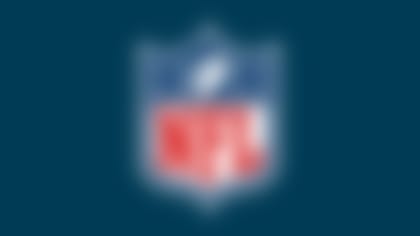As Philadelphia Eagles receiver DeSean Jackson prepared to return last weekend from his second concussion in less than a year, he was given a special, new helmet. While he hoped to be better protected, the helmet's maker certainly wouldn't -- and couldn't -- guarantee Jackson will be completely safe from brain injuries.
The truth is, no helmet can provide that sort of absolute protection in the NFL, where there's an average of 1.5 to two concussions in each game.
In a series of interviews with The Associated Press, representatives of the NFL, its players' union and the four equipment companies that make every helmet worn in the league all agreed there's no football helmet -- in production or on drawing boards -- that can eliminate concussions. And there might never be one.
The NFL acknowledges that the lack of a perfect helmet contributed to its decision in recent weeks to use hefty fines and the threat of suspensions to cut down on dangerous hits. It's also why the league's head, neck and spine medical committee is holding a two-day meeting next month to look into new ways to test and design helmets.
"A concussion-proof helmet? So far, there's nothing to that effect," said Ray Anderson, the NFL's executive vice president of football operations. "I don't know if (manufacturers) could ever convince us or assure us that a helmet that would absolutely prevent concussions is doable. I haven't heard such a thing."
Right now, the helmet makers know they can't make such claims.
"I don't think there'll ever be anything that's a concussion-proof football helmet. I've heard that term thrown around, but in the helmet world, with today's technology, that's not achievable," said Thad Ide, vice president of research and development at Riddell.
"It's important to understand that there's a limit to how much helmets can do," Ide continued. "And player behavior, player education, rules changes -- all of those things can have as much, or more, of a benefit in reducing the risk of concussion."
Helmets used in the NFL - and NCAA or high school football, for that matter -- are supposed to pass a test developed by the National Operating Committee on Standards for Athletic Equipment (NOCSAE), a nonprofit corporation. The group's website notes that it establishes "voluntary test standards," that "manufacturers test their own helmets" and that "NOCSAE does not possess a surveillance force to ensure compliance with the standards."
The testing method established in the 1970s remains essentially the same today. The goal then was to prevent sudden death, skull fractures and brain bleeding in football -- not stop concussions -- and there's universal agreement that goal has been achieved. But NOCSAE says it would like to find a way to update the standard and testing to account for concussions, once more is known about the forces that cause them.
"We can't make a change to our standard until, No. 1, we know it's going to be beneficial, and No. 2, that the change that we would incorporate wouldn't make the rest of the standard less protective or that the change wouldn't increase the risk of injury in another area," executive director Mike Oliver said. "Science doesn't know the answer."
Concussions occur when the brain moves inside the skull from an impact or a whiplash effect. Some compare it to the movement of a yolk within a shell if an egg were tossed out of a window -- yes, wrapping the egg in bubble-wrap might keep the shell from cracking, but it wouldn't stop the yolk from jostling.
"I don't think this is a different set of problems than car manufacturers face when developing air bags or car seats for children," Schutt Sports president and CEO Robert Erb said.
"I can't have the helmet weigh too much, because then I'm putting stress loads on the neck and I'm creating a whole set of different problems. I can't put in too much padding, because then I'm creating a heat-related issue. I can't make it too thin. I can't make it too thick," said Erb, whose company made Jackson's old and new helmets.
Mark Lovell, founding director of the University of Pittsburgh Medical Center Sports Medicine Concussion Program, said a concussion-proof helmet is not "a realistic goal, because you can't put a helmet on the brain."
"The helmet sits on the skull, and the brain moves inside the skull, and that's actually what causes the concussion," said Lovell, who has served as a consultant to the NFL and other major sports leagues.
Factors that play into whether concussions happen include whether a player took previous hits to the head that day; how hydrated he is; where on the helmet he gets hit; whether the player saw the hit coming and was able to tense neck muscles so his head spins less violently.
And the list goes on.
"I don't personally think, in my own mind, the helmet is ever going to be the solution to concussions. But I think they can be made better in the future, just like the current ones are made better than they were in the past," said Dr. Robert Cantu, a clinical professor of neurosurgery at the Boston University School of Medicine, senior adviser to the NFL's concussion committee and NOCSAE vice president.
The NFL's Anderson said it's "exactly right" to make a connection between the current state of helmet technology and the efforts by the league to increase enforcement of rules governing illegal hits to the head, including fines of up to $75,000.
"It's very clear that wearing a helmet, in and of itself, is not protecting our guys from concussions and other trauma," said Anderson, who makes initial decisions on punishment for NFL safety-rule violations, "so to the extent that we can do more by aggressively enforcing our rules and getting illegal techniques and hits to the head out of the game, we have an obligation to do that."
The NFL and NFLPA concussion committees, helmet makers, the Department of Defense and leading scientists will participate in discussions Dec. 8-9 to: examine whether there are new materials that could improve helmets; determine if sensors should be used in helmets, mouthguards or earpieces worn by NFL players to measure impacts of various kinds of hits to the head; review the NFL's return-to-play guidelines established in December 2009, including considering whether sideline tests used to determine if a player has a concussion should be standardized so each team uses the same, mandated neurological exam.
"We're turning over every stone you could imagine," said Richard Ellenbogen, chairman of the University of Washington medical school's department of neurological surgery and co-chair of the NFL's head, neck and spine medical committee.
The NFL says it has invested $10 million on the issue since 2006, including $6 million on concussion- and helmet-related research and education.
"We certainly won't get a helmet that reduces concussions," said Thom Mayer, medical director for the players' union, "unless we try."
The helmet makers say they are trying.
Boston University's Cantu quickly rattled off advances such as Riddell's increased width, Schutt's new cushioning materials, and what he called Xenith's "rather dramatic" change from traditional foams to air-cell padding inside helmets.
No matter what advancements have come about, some NFL players sound skeptical about just how much protection helmets can provide.
"They're making tons of different styles of helmets, and I wear the old, traditional style. I kind of feel, like, if you're going to get knocked out, you're going to get knocked out," Indianapolis Colts cornerback Jerraud Powers said. "I don't really think the helmet matters when it comes to you having a concussion or not."
Said Pittsburgh Steelers safety Troy Polamalu: "I've heard players try out the new helmets, get concussions and say, 'I'm going back to the old one.'"
Each player is allowed to choose which brand he wears. The NFL estimates that 75 percent of helmets used this season are made by Riddell, which has had a licensing/sponsorship agreement with the league since 1990; 23 percent are made by Schutt, 1 to 2 percent by Xenith, and a handful by Adams USA. Rawlings, which stopped making football helmets more than two decades ago, is returning to the business in 2011 and has partnered with the Cleveland Clinic for concussion research.
According to Schutt, the Eagles' Jackson had been wearing one of its helmet models that went out of production about two years ago. Then came Oct. 17, a Sunday filled with some particularly vicious hits across the NFL, including the shot Jackson took from Atlanta Falcons cornerback Dunta Robinson that left both men on the ground, motionless. Jackson and Robinson both ended up with concussions; each missed his team's next game; Robinson appealed the $50,000 fine levied by the league for the hit.
D.J. MacLean, Schutt's director of sports marketing, traveled to Philadelphia last week to check on Jackson and his new helmet -- outfitted, unlike his old Schutt, with a material the company says does a much better job of withstanding impacts.
Still, MacLean will be the first to tell you, that material can't ensure those impacts don't cause concussions.
"For somebody to say that there is such a thing as a concussion-proof helmet is incorrect. It's a misinterpretation. Football is a collision sport. When it's played well, it's a violent collision sport. Concussions will happen," MacLean said. "The only way to not get one is to sit in the stands."
Copyright 2010 by The Associated Press



